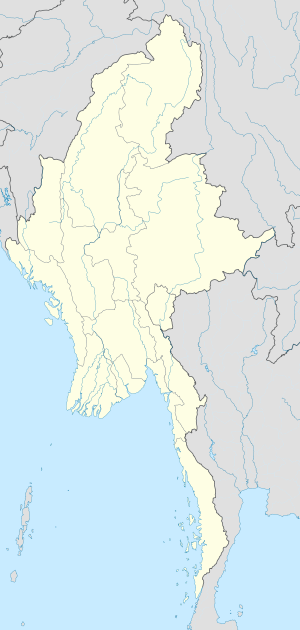Mahamuni Buddha Temple
| Mahamuni Buddha Temple Maha Myat Muni Buddha Image |
|
|---|---|

Mahamuni Image
|
|
| Basic information | |
| Geographic coordinates | 21°57′6.73″N 96°4′43.03″E / 21.9518694°N 96.0786194°ECoordinates: 21°57′6.73″N 96°4′43.03″E / 21.9518694°N 96.0786194°E |
| Affiliation | Theravada Buddhism |
| Country | Mandalay, Mandalay Region, Myanmar (Burma) |
| Architectural description | |
| Founder | King Bodawpaya |
| Completed | 1785, rebuilt after 1884 fire |
The Mahamuni Buddha Temple (Burmese: မဟာမုနိဘုရားကြီး, Burmese pronunciation: [məhà mṵnḭ pʰəjádʑí]; also called the Mahamuni Pagoda) is a Buddhist temple and major pilgrimage site, located southwest of Mandalay, Myanmar (Burma) (Myanmar). The Mahamuni Buddha image (literal meaning: The Great Sage) is deified in this temple, and originally came from Arakan. It is highly venerated in Burma and central to many people's lives, as it is seen as an expression of representing the Buddha's life.
Ancient tradition refers to only five likenesses of the Buddha, made during his lifetime; two were in India, two in paradise, and the fifth is the Mahamuni Buddha image in Myanmar. According to the legend, the Buddha visited the Dhanyawadi city of Arakan in 554 BC. King Sanda Thuriya requested that an image was cast of him. After casting the Great Image, the Buddha breathed upon it, and thereafter the image became the exact likeness of the Mahamuni.
According to legend, the Gautama Buddha visited Dhanyawadi, the capital city of Arakan during his travels on a Proselytization mission to spread Buddhism. During the 26th anniversary of the King at the time, a devout Buddhist, the Buddha accompanied by Shin Ananda and 500 disciples landed at Salagiri mountain peak near Khaukrah town. The King of Arakan, along with his Chief Queen Sandra Mala (with her retinue of 1,600 ladies in waiting), and an entourage of ministers, generals and officials, paid homage to the Buddha. They were deeply moved by his teachings and upon his departure to Thawuthi (Sravasti), the King insisted that he leave his image for people to worship. For this purpose, the Buddha then sat under a Bodhi tree for a week of meditation. During this time Sakka (in Pāli, the ruler of the Trāyastriṃśa Heaven in Buddhist cosmology, supported by his assistant Vissakamma, moulded a lifelike image of the Buddha using ornaments donated by the king and his people. It is also said that Sakka and Vissakamma (or Vishvakarman) created a separate pavilion for the Buddha to live and enjoy during these seven days. After looking at his own lifelike image, believed at the time to have been his only true-likeness, Buddha was pleased and "imbued the image with his spiritual essence", or "enlivened and consecrated" the image, naming it "Candasara". He also stated that the image would last for five thousand years as his representative.
...
Wikipedia

